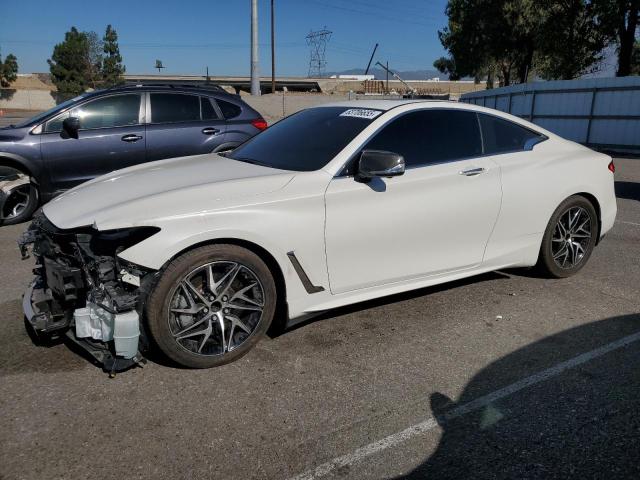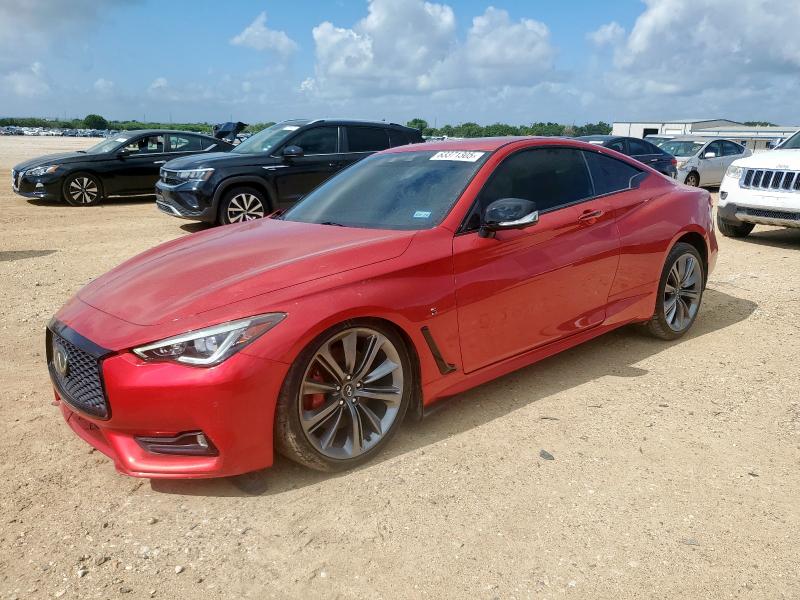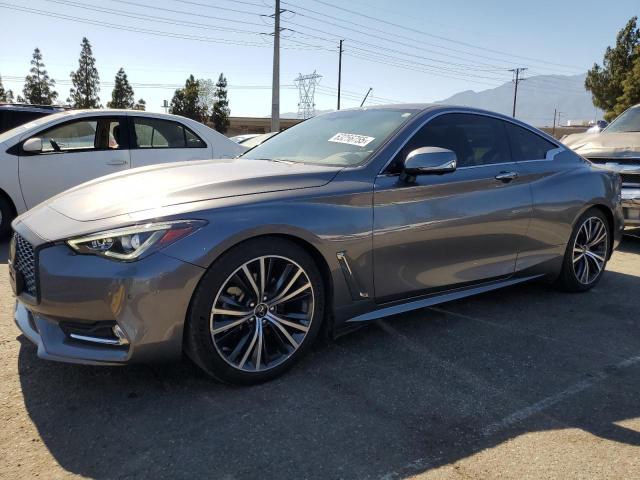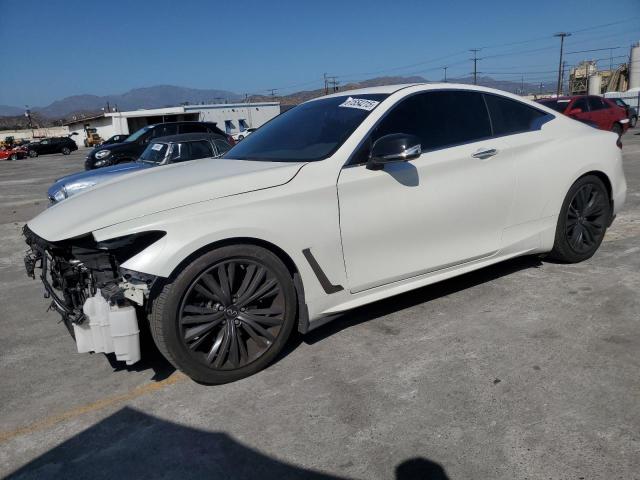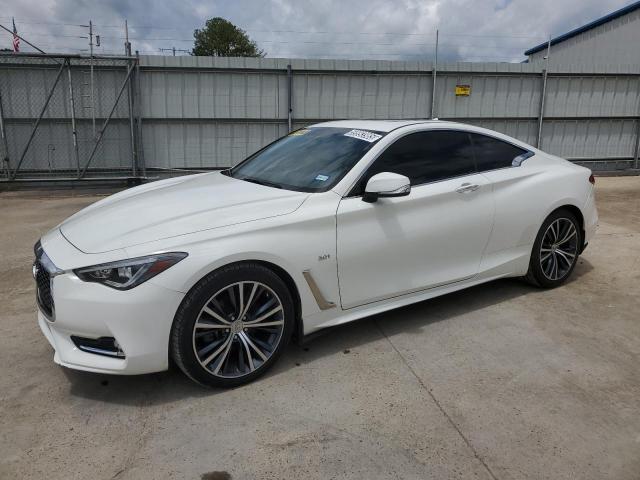2022 INFINITI Q60 | JN1FV7LL5NM680815
Lot details
- Sale Date2025-06-09
- Lot Number42114128
- ACV46332 $
- Sale documentSalvage (Massachusetts)
- LocationDream Rides (IL)
- Odometer15,584 miles (25,080 km)
- Primary DamageFRONT END
- Secondary DamageUNKNOWN
- SellerHanover Insurance
Vehicle specifications
3
~$60,000
Engine: 3.0L Twin-Turbocharged V6
Torque: 475 Nm
0–100 km/h: ~4.5 s
The Infiniti Q60 Red Sport 400 was Infiniti’s boldest attempt at crafting a luxury grand tourer with serious performance credentials. With 400 hp and 475 Nm from its high-output VR30 twin-turbo V6, it delivered confident acceleration, reaching 100 km/h in about 4.5 seconds with AWD — enough to rival the BMW 440i, Audi S5, and even undercut the Lexus RC F in a straight line.
But the Q60 wasn’t just about power. It featured adaptive Dynamic Digital Suspension, optional Direct Adaptive Steering (steer-by-wire), and a low, wide stance that gave it a planted, luxurious feel. The chassis prioritized comfort over raw agility, making the Red Sport 400 more of a high-speed cruiser than a corner carver — a unique position in the segment.
The interior boasted dual-screen infotainment (though dated by 2022 standards), quilted leather seats, and high-quality finishes. Its coupe profile, muscular fenders, and crescent-cut C-pillar gave the Q60 a distinctive, sculpted presence that aged gracefully over its production run.
The Q60 Red Sport 400 earns its place in the performance registry as Infiniti’s most powerful road-going coupe ever, blending twin-turbo V6 strength with GT refinement. It represents a now-closed chapter where Nissan’s luxury brand flirted seriously with performance luxury, just before electrification began reshaping the segment.
Final Bid Infiniti Q60 (2022)
$10,300
$16,138
$22,100
Body Styles
The Infiniti Q60 was offered exclusively as a 2-door luxury coupe, with flowing proportions and an unmistakably Japanese approach to sculptural design. Inspired by the Q80 concept, it featured a low-slung silhouette, double-arch grille, and crescent-shaped C-pillar, which gave it a dramatic and modern profile.
Though sleek and aggressive, the Q60 maintained real-world usability, offering decent trunk space (342 liters) and respectable rear seating for a coupe. It also featured active grille shutters for better aero, zero-lift bodywork, and optional Dynamic Digital Suspension for improved handling comfort.
The overall aesthetic struck a balance between elegance and muscle, setting it apart from more traditional German coupes.
Model Name Meaning (Manufacturer)
The name "Q60" follows Infiniti's naming shift from “G37” and “M37” to alphanumeric designations based on size and segment. “Q” refers to cars (as opposed to QX for SUVs), and “60” indicates its place near the top of the sedan/coupe range — despite using 2.0L or 3.0L engines.
This shift was part of Infiniti's repositioning as a design- and technology-led premium brand, emphasizing clean, minimalist branding inspired by Japanese calligraphy and nature. The Q60 name signaled a more mature, confident coupe than its G-series predecessors.
Body & Interior Colors and Rims
The Infiniti Q60, a luxury sport coupe derived from the Q50 sedan, was engineered to balance performance, elegance, and dramatic design. Its sweeping body lines, driver-focused interior, and aggressive stance were all enhanced by a carefully selected range of paint colors, interior trim combinations, and wheel options, making the Q60 both visually distinctive and unmistakably premium.
The exterior color palette featured a mix of classic metallics and bold signature finishes. Elegant tones like Graphite Shadow, Majestic White, Liquid Platinum, and Black Obsidian emphasized the coupe’s luxury appeal and paired well with chrome or silver trim accents. For buyers seeking more visual impact, Infiniti offered vibrant colors such as Dynamic Sunstone Red, a rich, deep metallic red that became a signature Q60 color, and Iridium Blue, a bold electric blue that accentuated the car’s sculpted flanks and muscular proportions. Additional hues like Slate Gray, Pure White, and Grand Blue offered variety across trims, while Red Sport 400 models often featured exclusive high-gloss paint finishes that played with light and shadow, particularly under sharp creases and flowing rooflines.
Inside, the Q60 delivered a premium, sporty cabin with layered surfaces, contrast stitching, and a dual-screen infotainment layout. Interior themes varied by trim, with base and Luxe models offering graphite (black), stone (light gray), or wheat (beige) leatherette or leather upholstery. Upper trims, especially the Sport and Red Sport 400, featured semi-aniline leather in Monaco Red, Gallery White, or Graphite, often with dark silver or brushed aluminum trim. Red Sport interiors added contrast piping, aluminum pedals, and paddle shifters, with some packages offering carbon fiber inlays or black headliners for a sportier, high-contrast appearance. The seats were well-bolstered and power-adjustable, with optional heating and cooling, while ambient lighting and dual-screen displays created a modern tech-forward feel.
Wheel designs on the Q60 were critical to its stance and character, ranging from 18 to 20 inches, depending on trim. Base models came with 18-inch twin-spoke silver alloys, while Luxe and Sport trims introduced 19-inch split-spoke or machine-finish wheels, sometimes with dark gray accents. The performance-oriented Red Sport 400 stood out with 20-inch staggered wheels in dark chrome or polished finishes, often with low-profile performance tires and red-painted brake calipers, reinforcing its 400-hp twin-turbo V6 credentials. Some special editions included unique turbine or blade-style wheels, enhancing airflow and visual movement even at a standstill. Optional wheel packages allowed for further personalization, often tailored to regional or year-specific trim packages.
Top Expensive Options
- ProACTIVE Package (adaptive cruise, lane assist): ~$2,500
- Dynamic Digital Suspension + Direct Adaptive Steering: ~$1,500
- Bose Performance Series 13-Speaker Audio: ~$1,200
- Carbon Fiber Interior Package (trim, console): ~$1,100
- Heated Seats and Steering Wheel: ~$700
- Navigation with Infiniti InTouch Services: ~$800
- Around View Monitor with Moving Object Detection: ~$900
- 20" Staggered Aluminum-Alloy Wheels: ~$1,200
- Red Sport-Exclusive Aero Kit (rear spoiler, lower valance): ~$1,500
- Monaco Red Semi-Aniline Leather Interior: ~$950
vs Competitors
The Q60 targeted the BMW 4 Series Coupe, Audi A5/S5, Lexus RC, and Genesis G70 Coupe. While German rivals offered sharper chassis tuning and more advanced infotainment, the Q60 countered with more standard power, bolder design, and superior ride comfort.
The Red Sport 400, in particular, outgunned many V6 and turbo-4 rivals in straight-line speed, with 0–100 km/h in under 4.5 seconds. The optional steer-by-wire system and adaptive suspension provided a unique, customizable driving feel — though purists debated the lack of steering feedback.
Compared to the Lexus RC 350, the Q60 offered stronger acceleration, better tech integration, and a more premium cabin. Against the BMW 440i, it was less agile but more refined in daily driving.
Fun Fact
The Q60 Red Sport 400 uses a VR30DDTT twin-turbo V6, an engine derived from Nissan’s performance program that also powered the Nissan Z and Infiniti Q50 Red Sport. With 400 hp from just 3.0 liters, it’s one of the most powerful non-V8 engines in its class.
Also, the Direct Adaptive Steering system used by the Q60 was one of the world’s first production steer-by-wire systems, enabling variable steering ratios, filtering out road harshness, and even customizing steering feel per drive mode — all without a mechanical column connection (though a backup link exists for safety).



